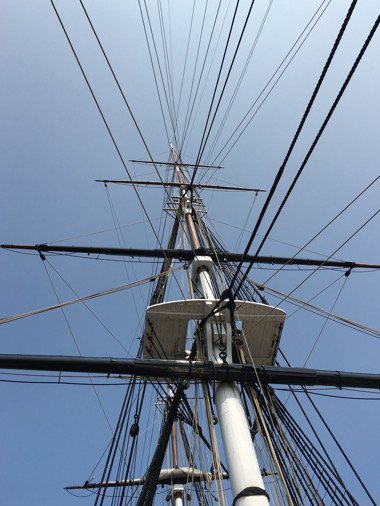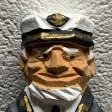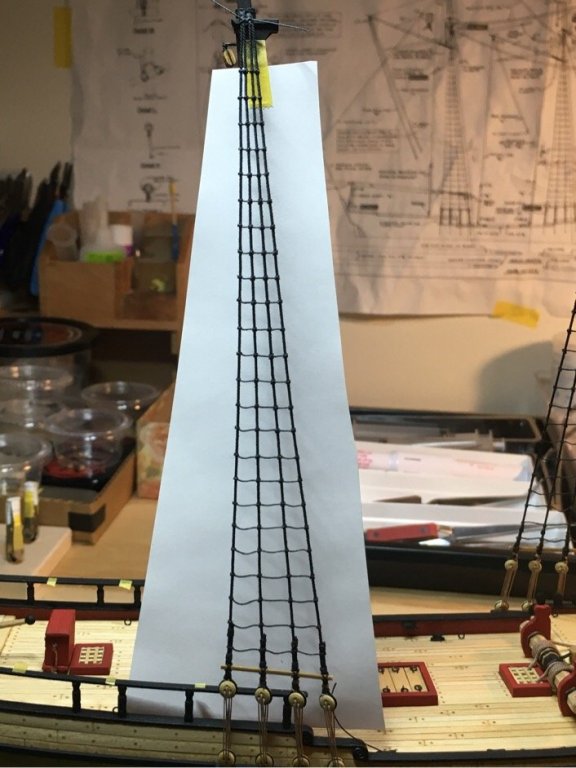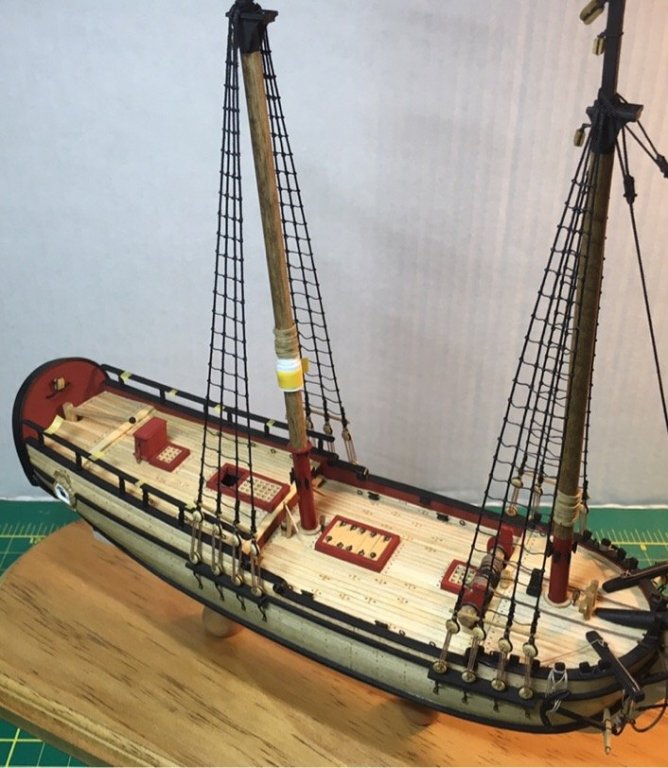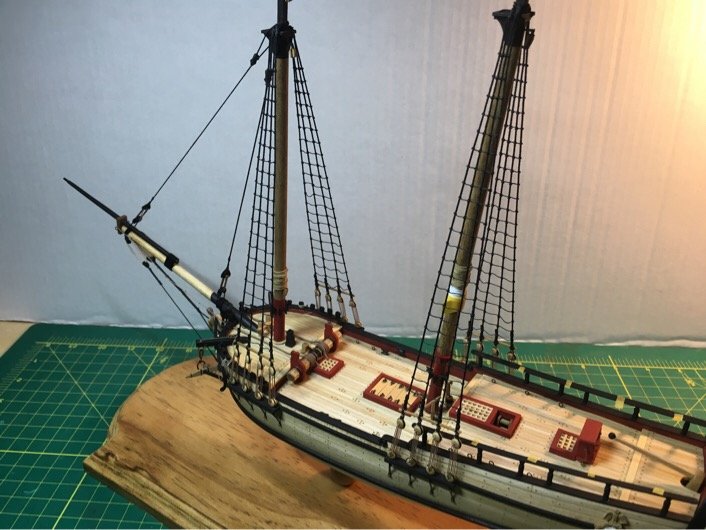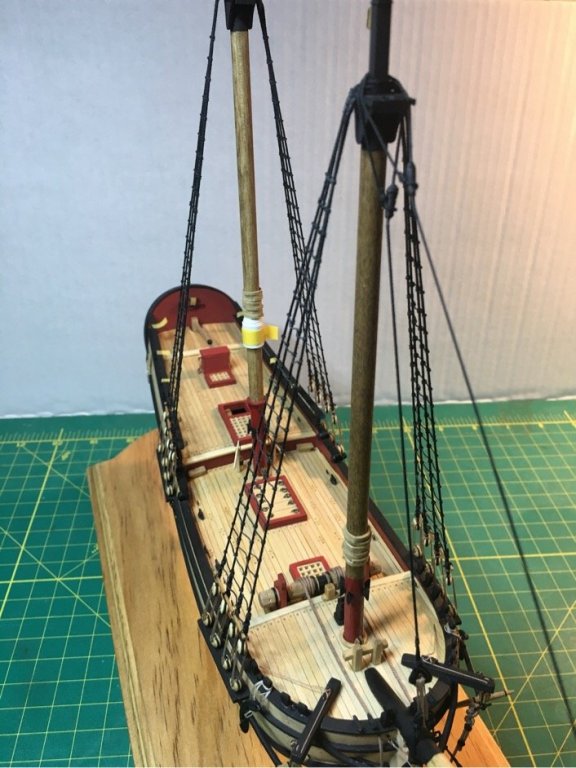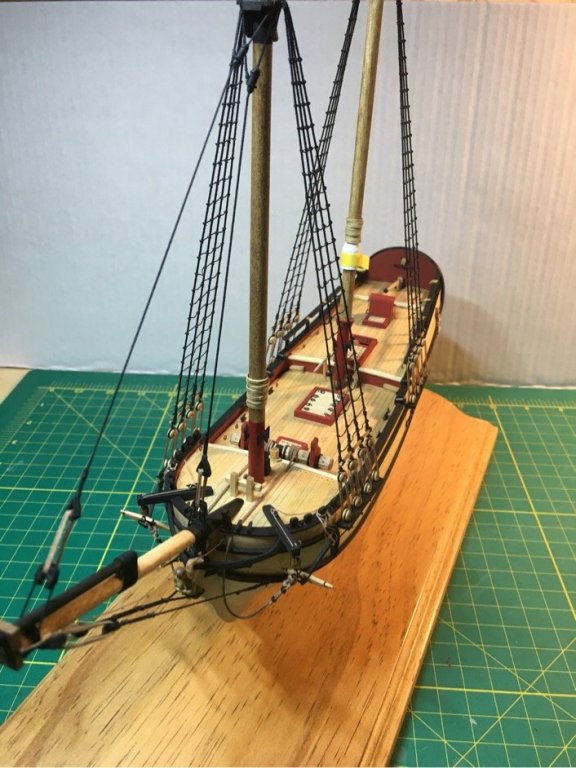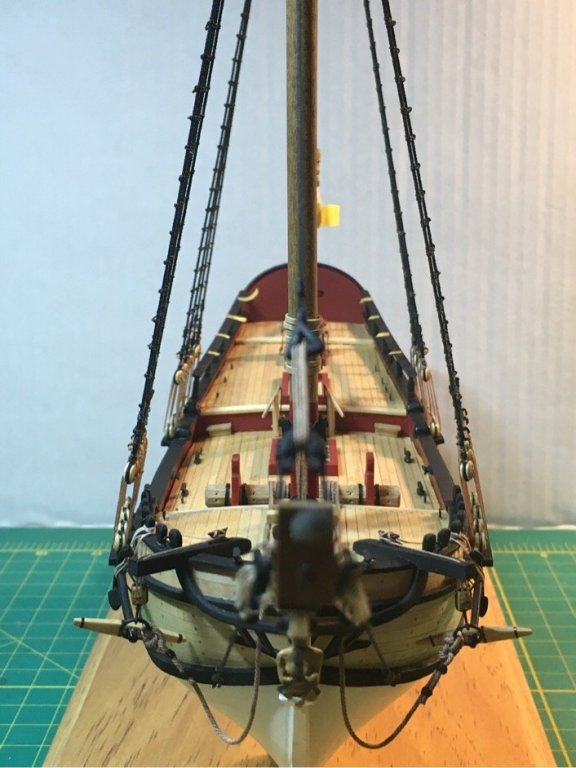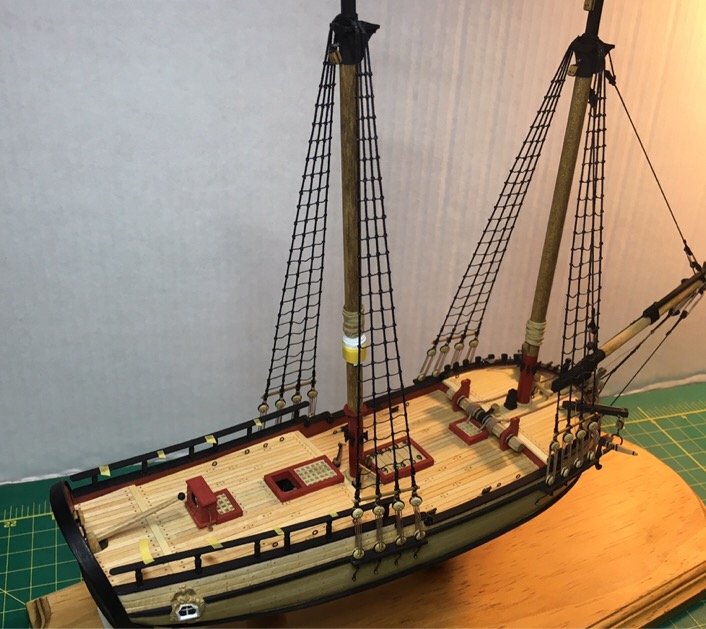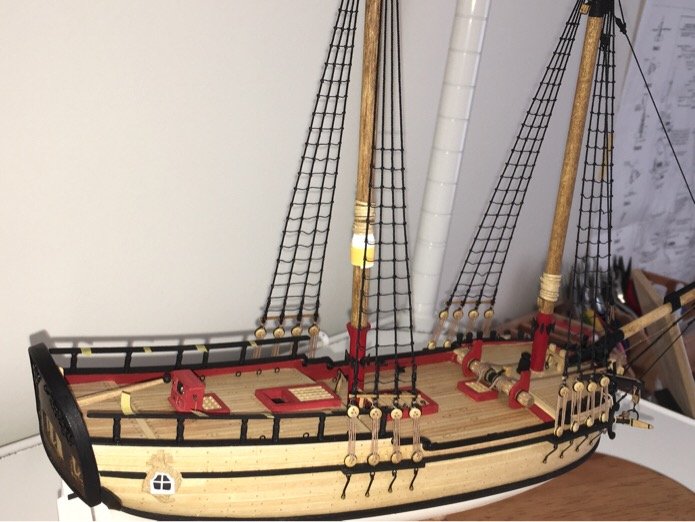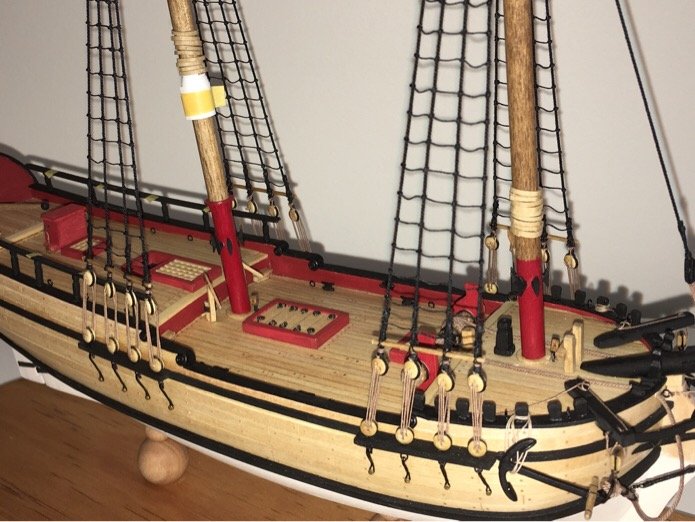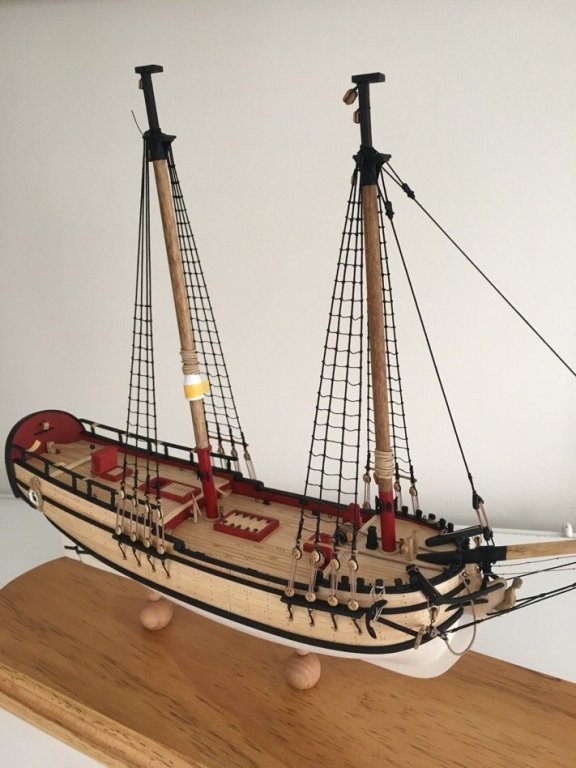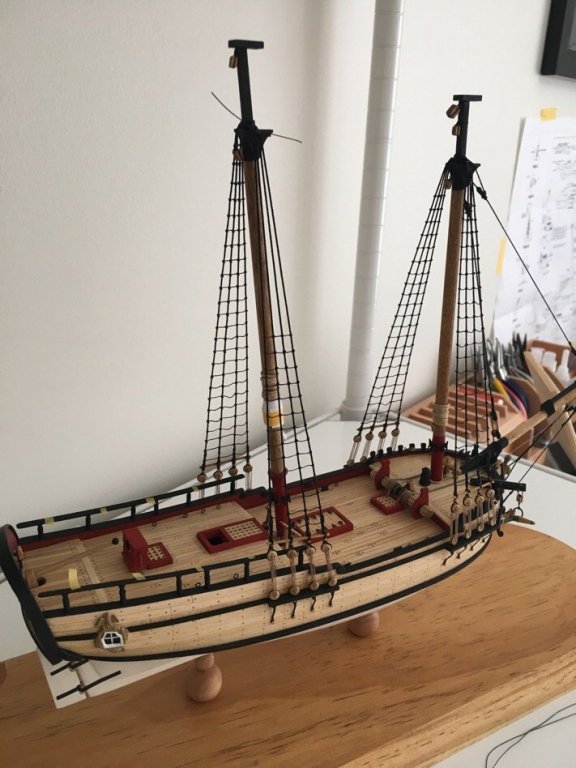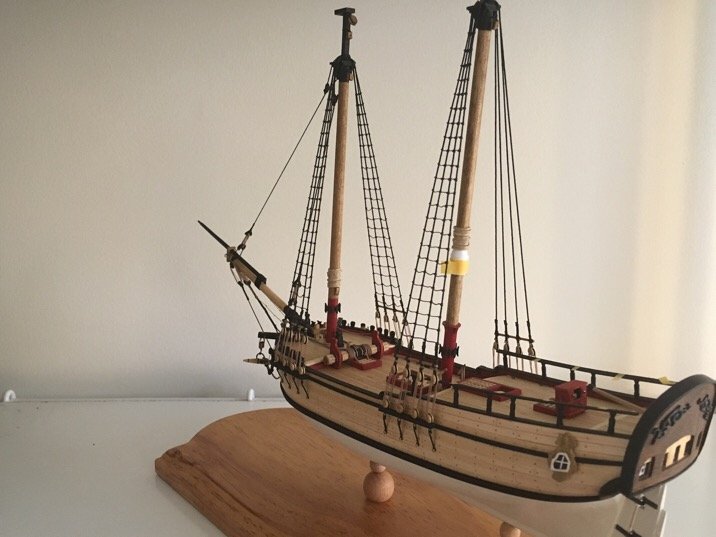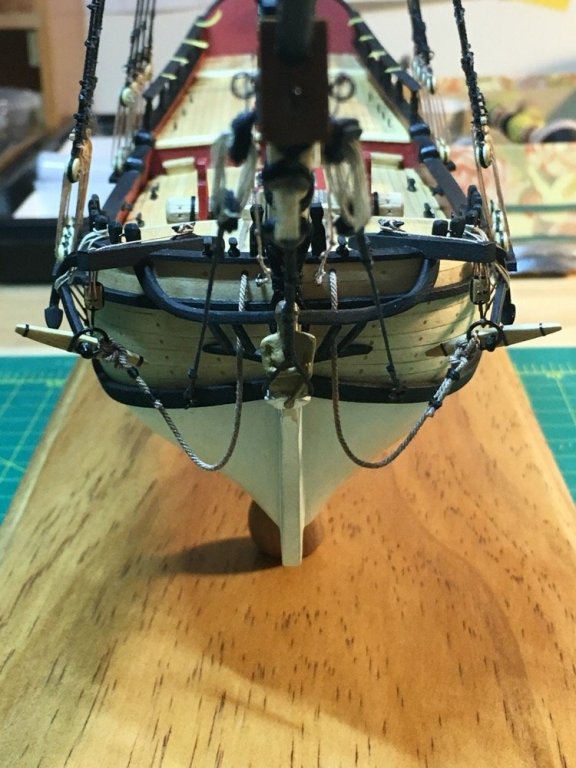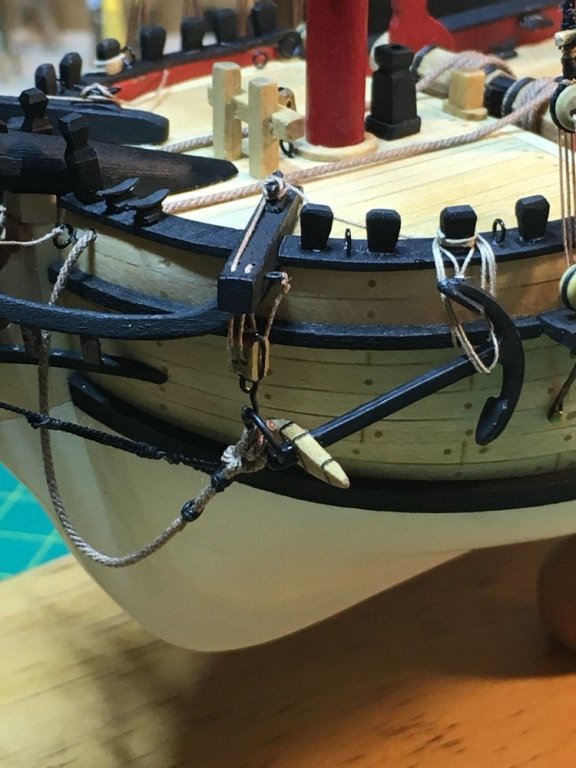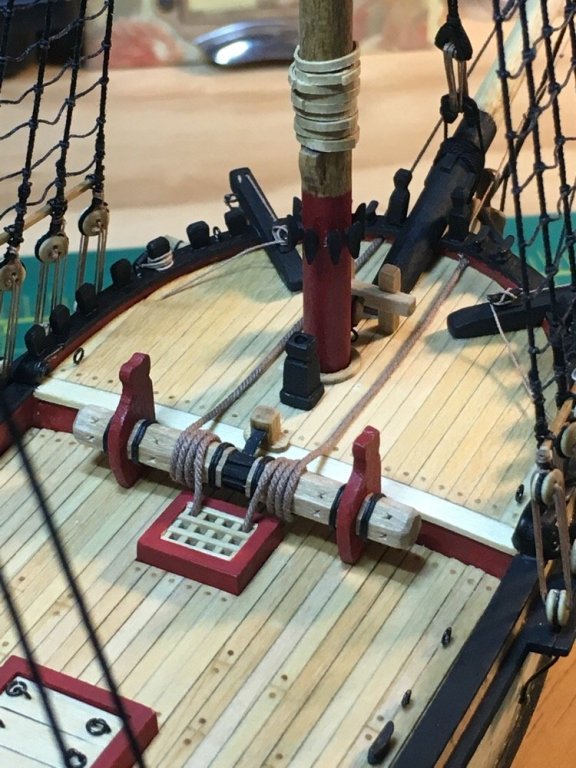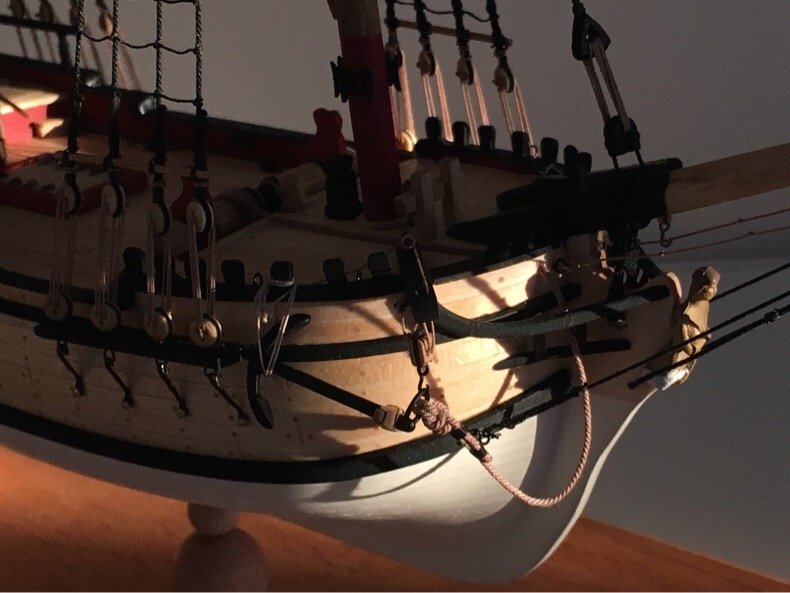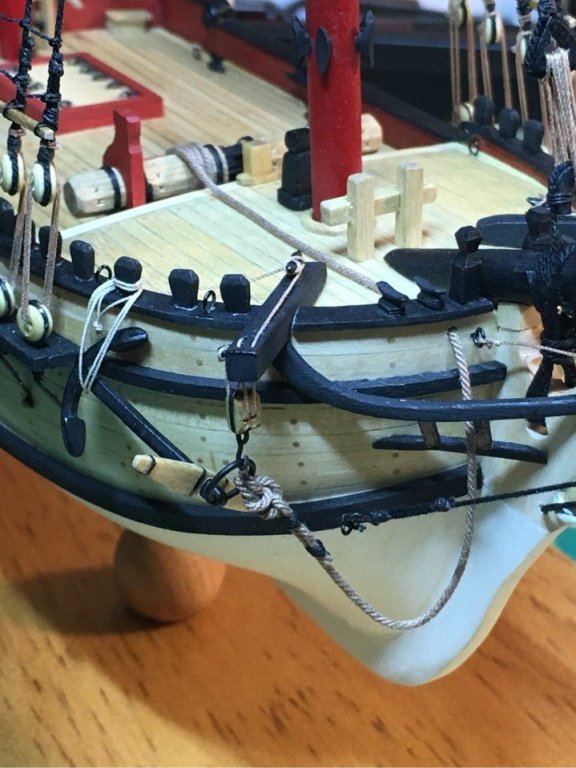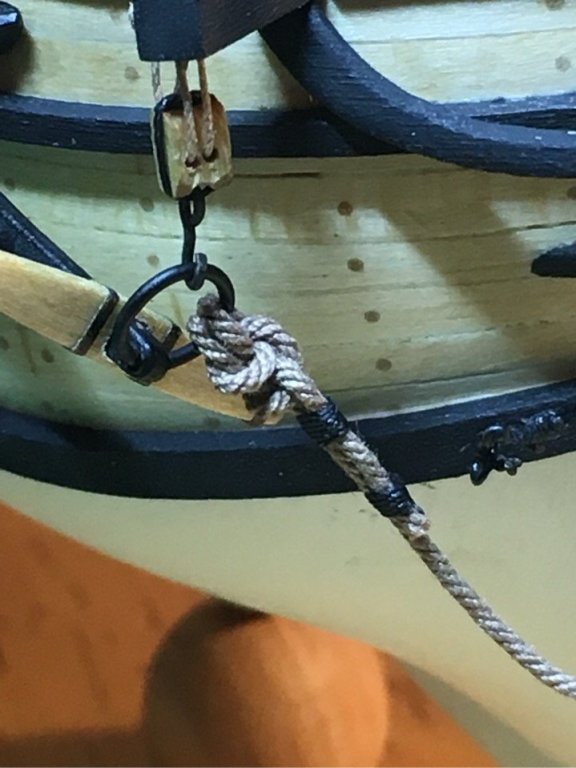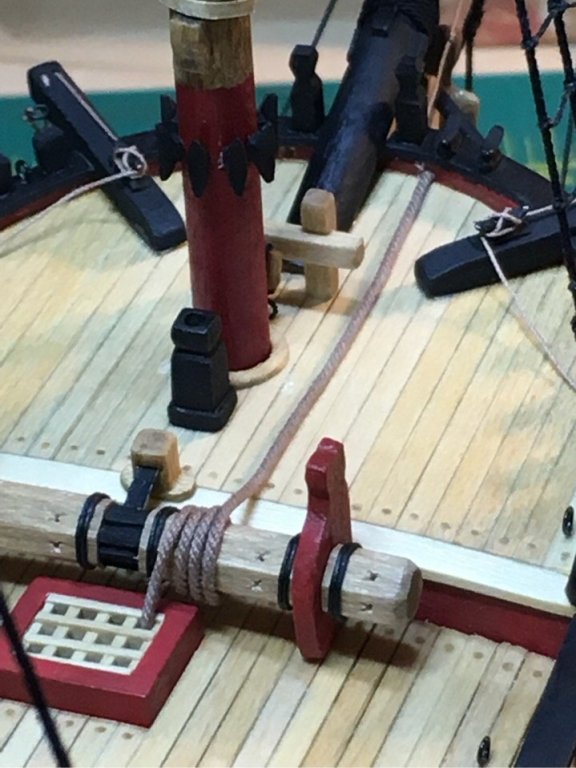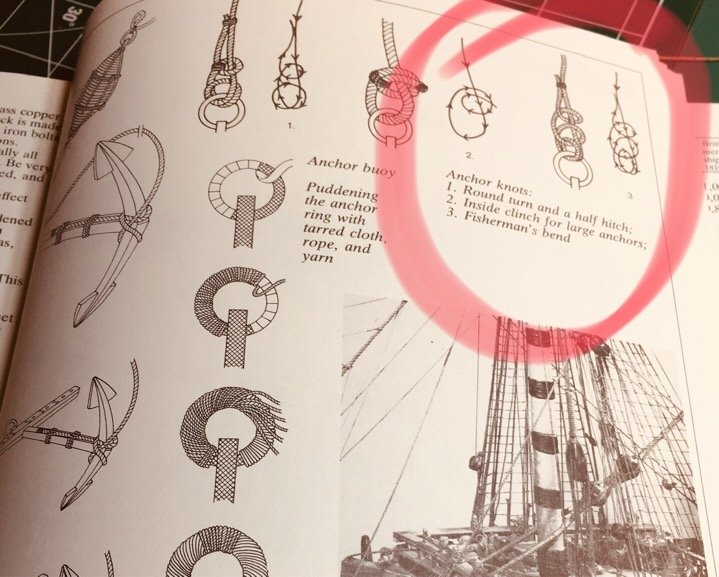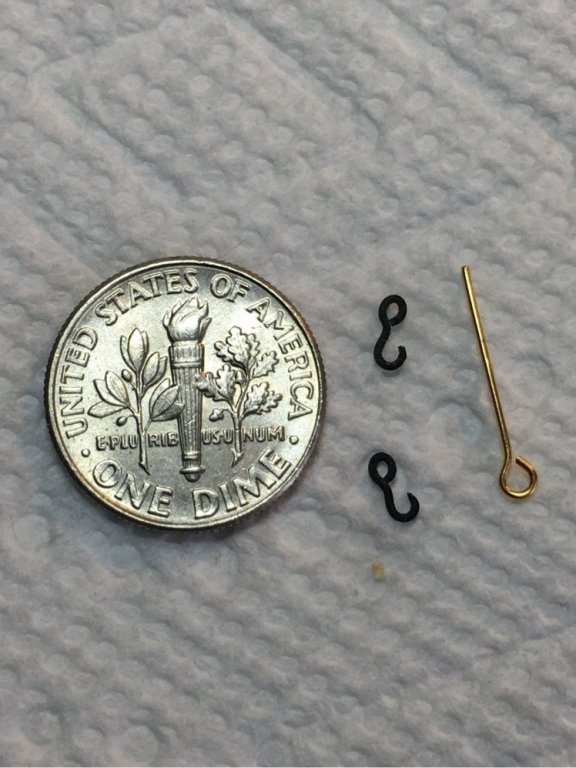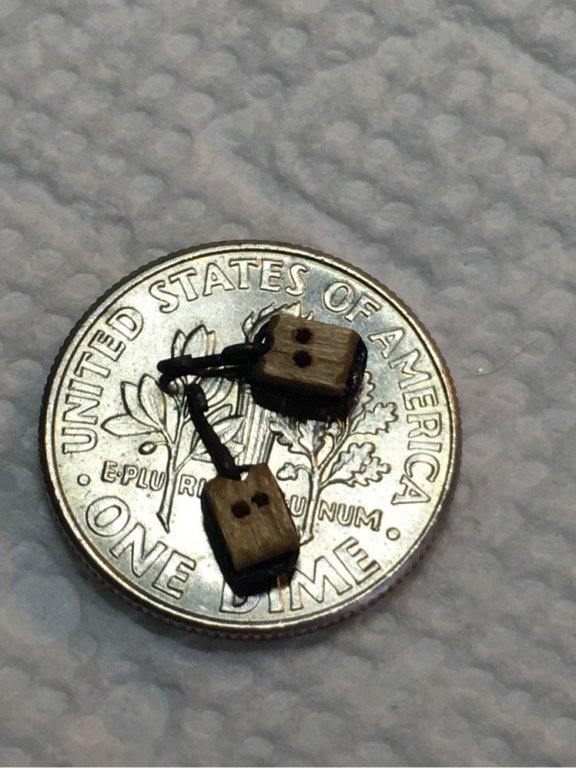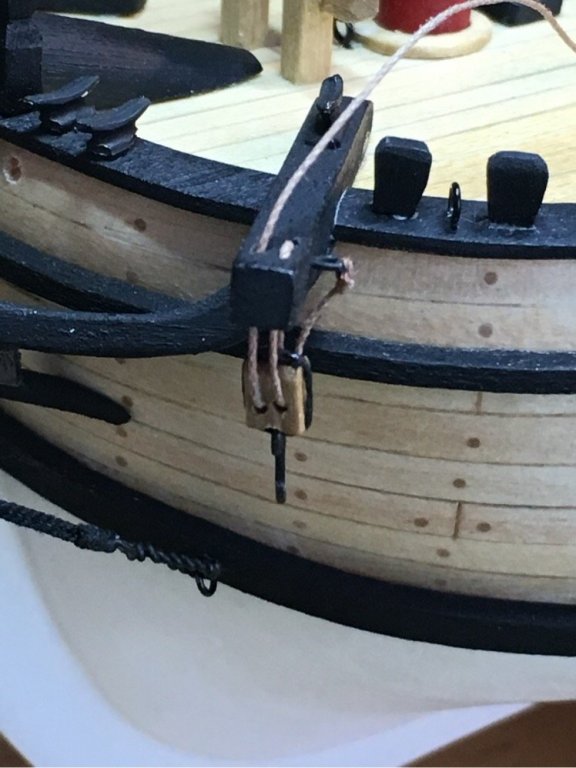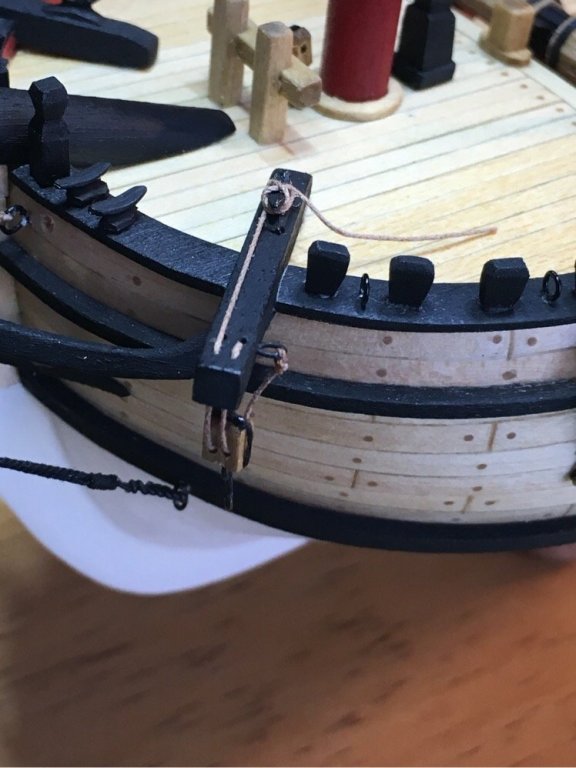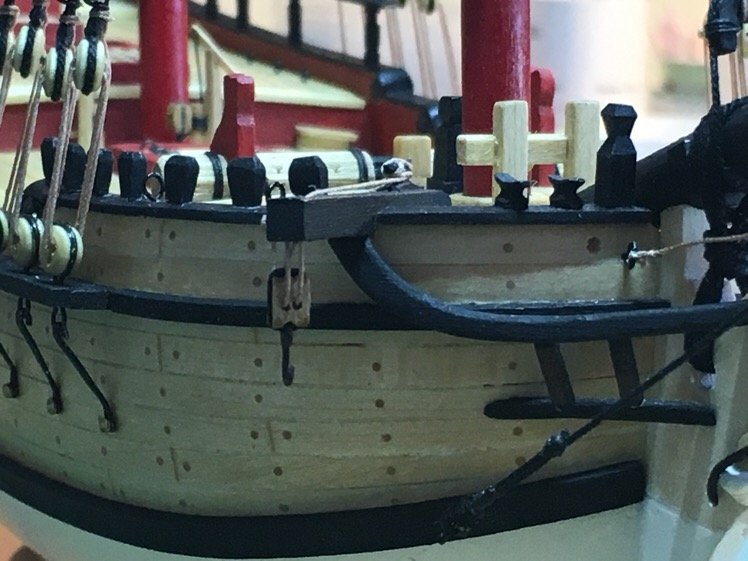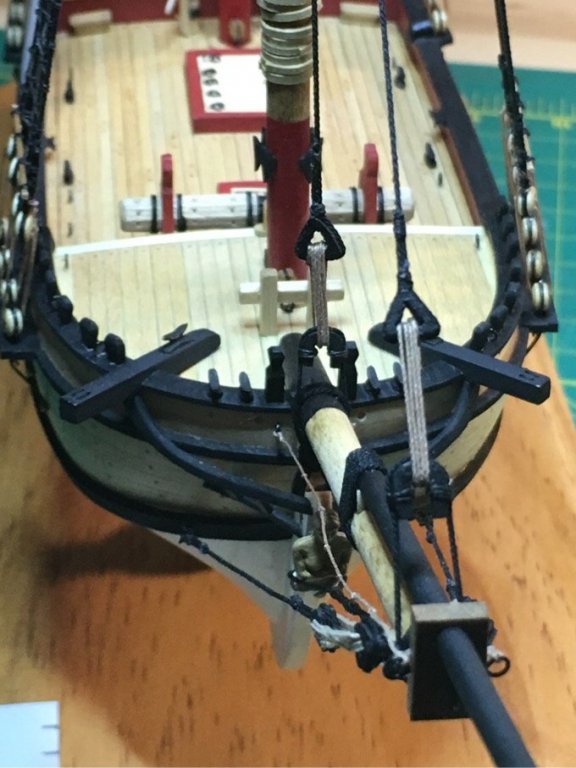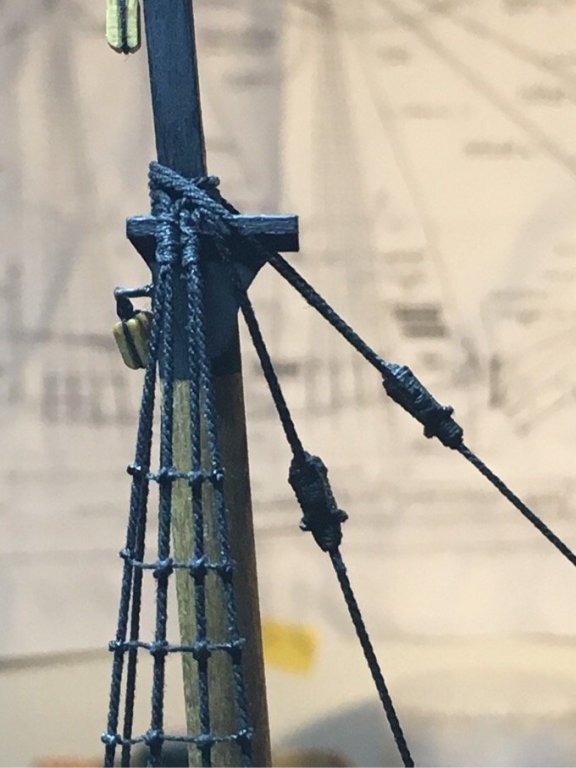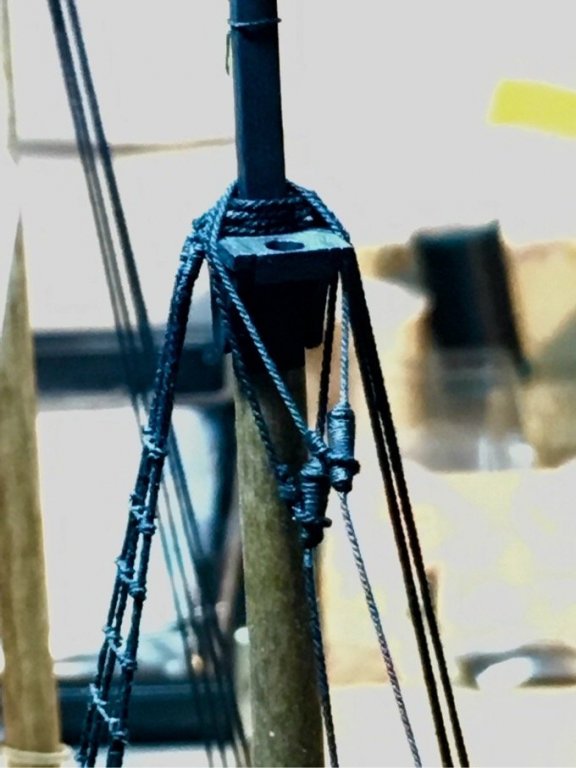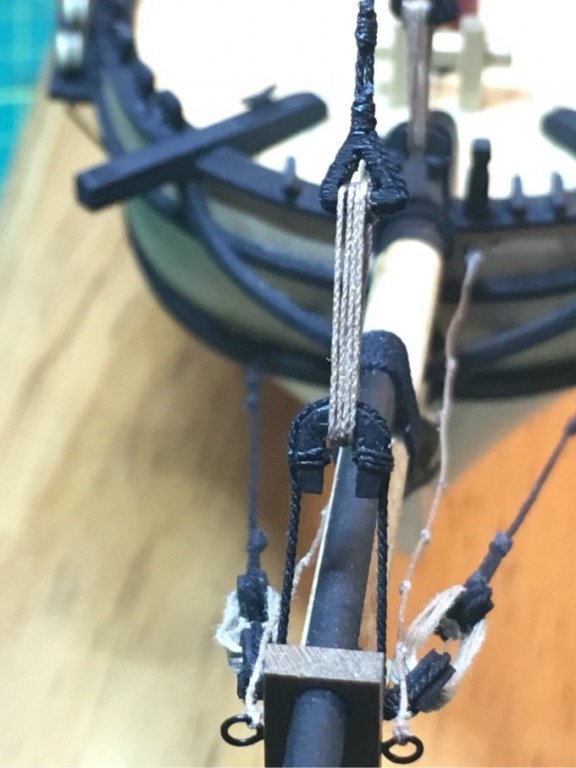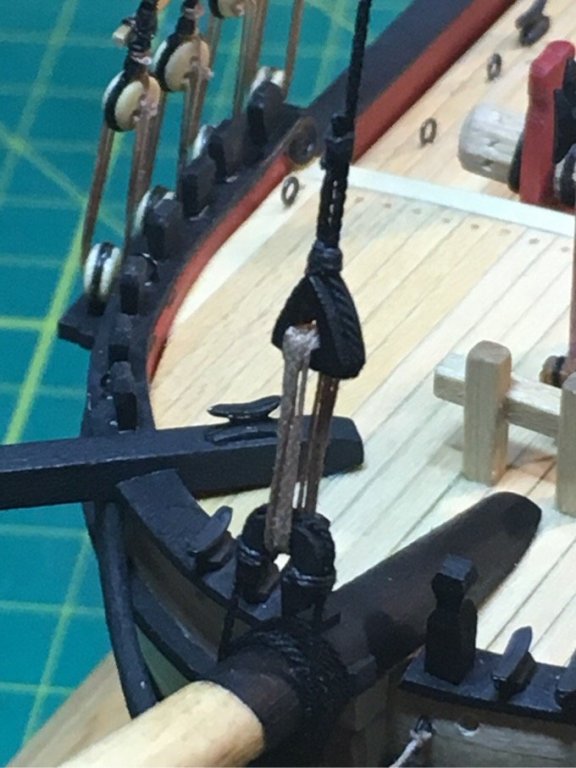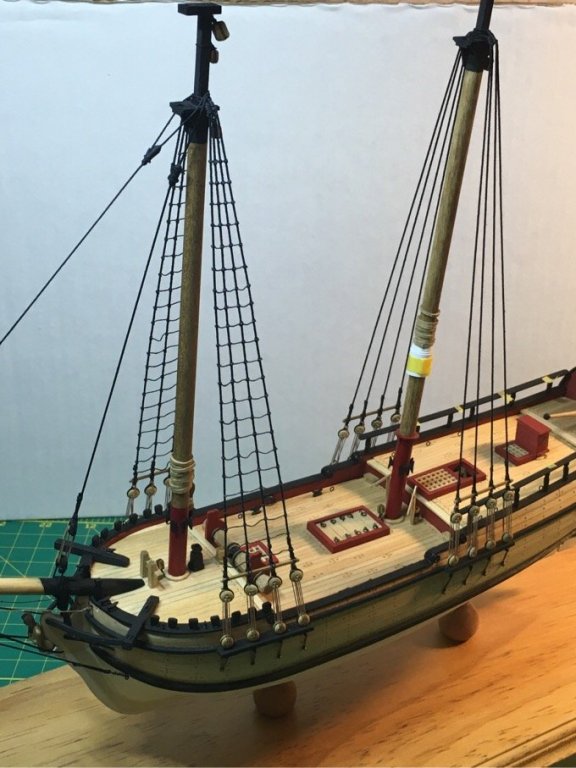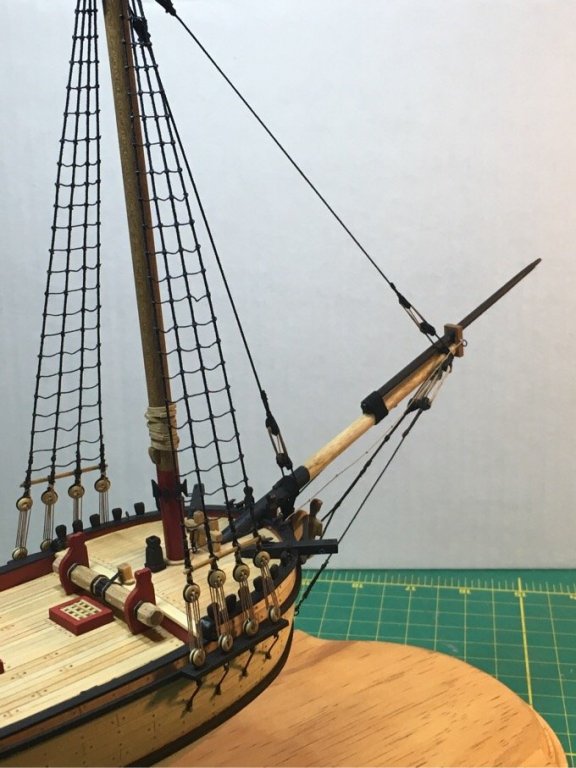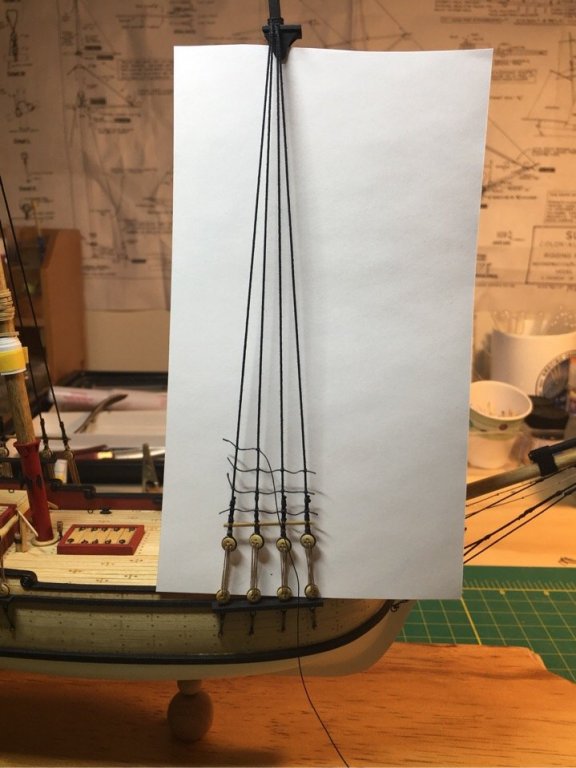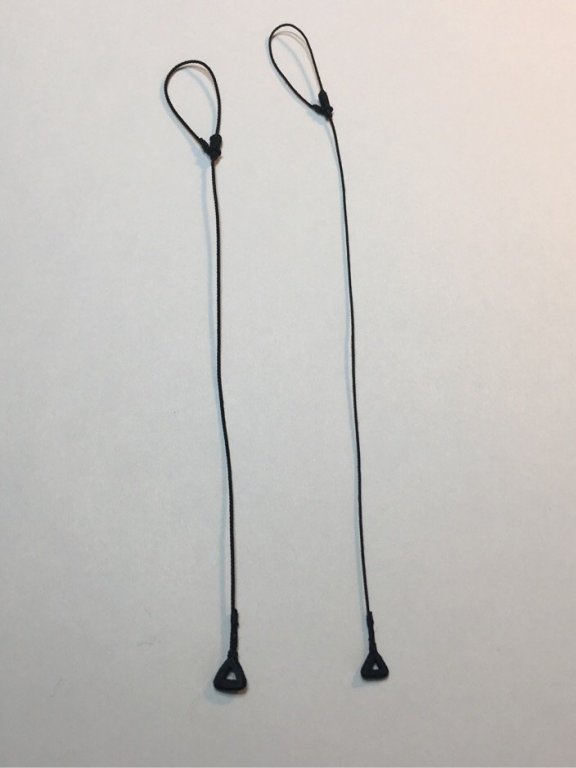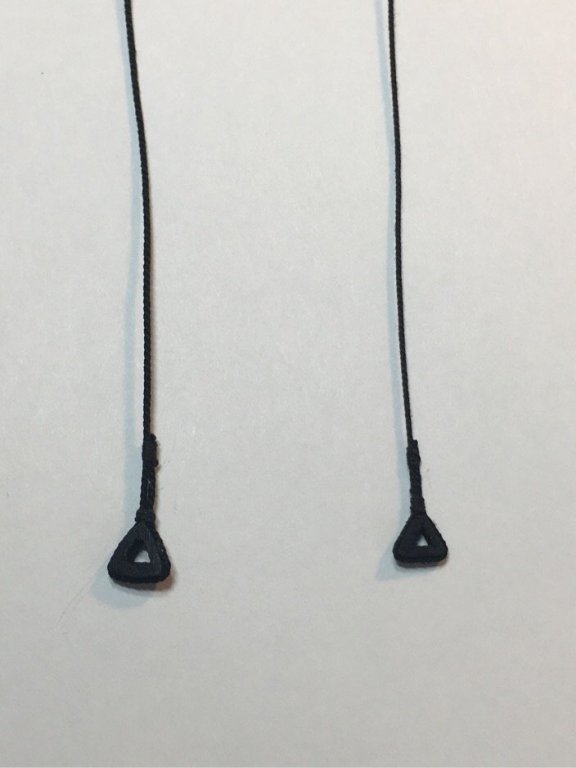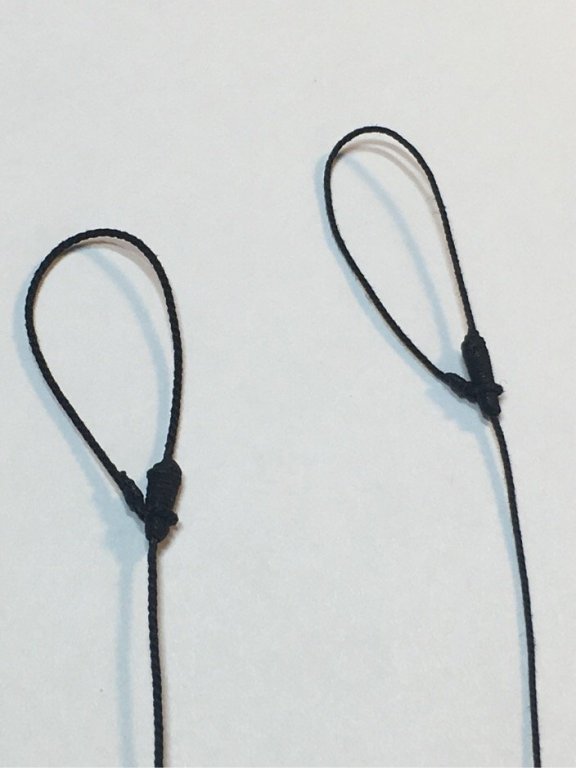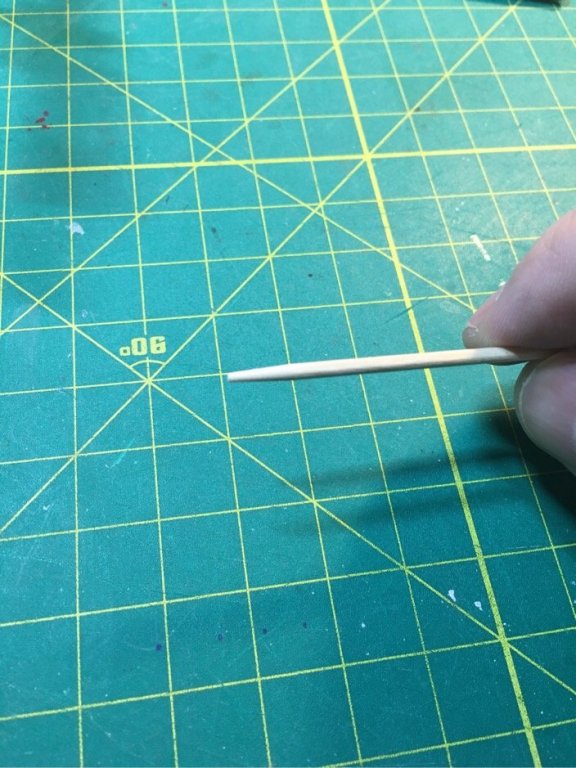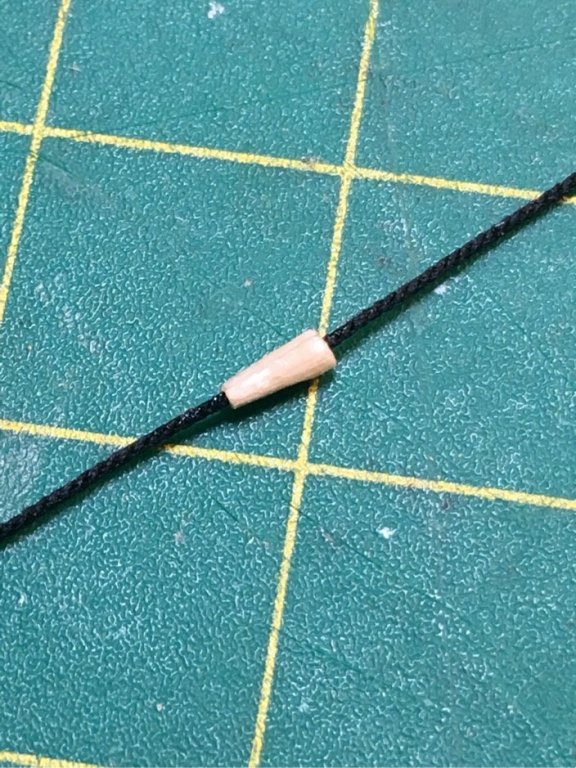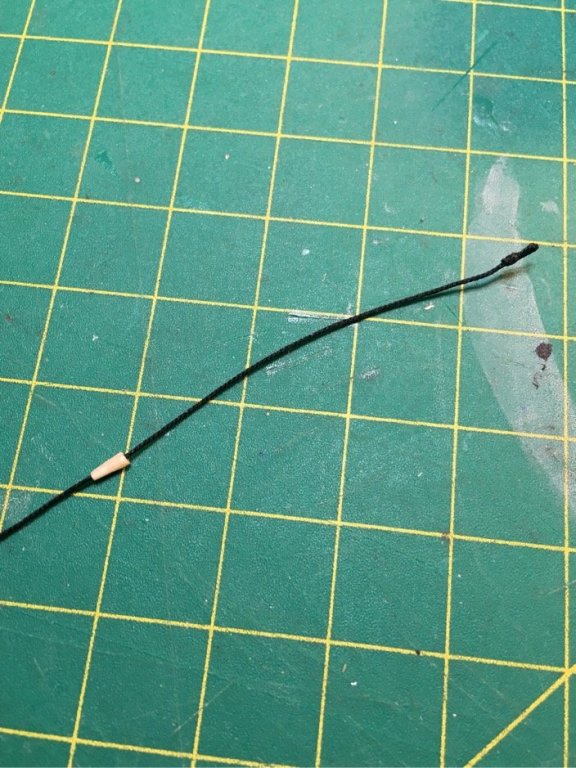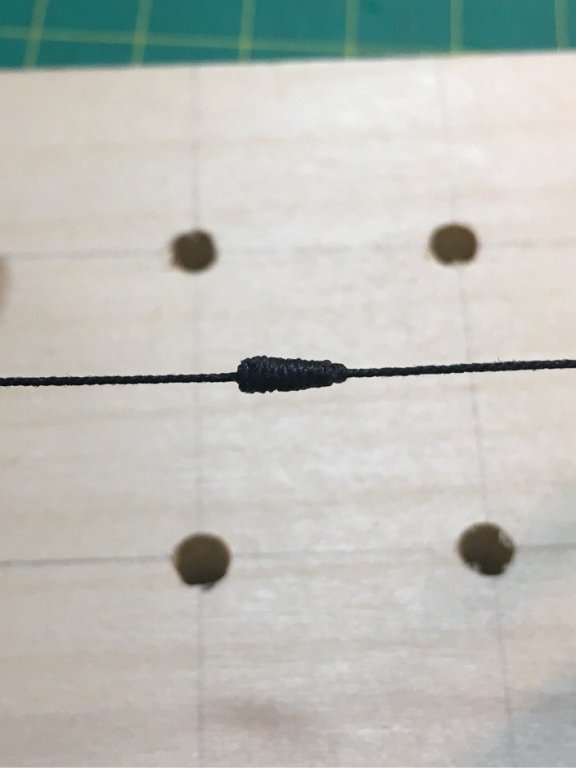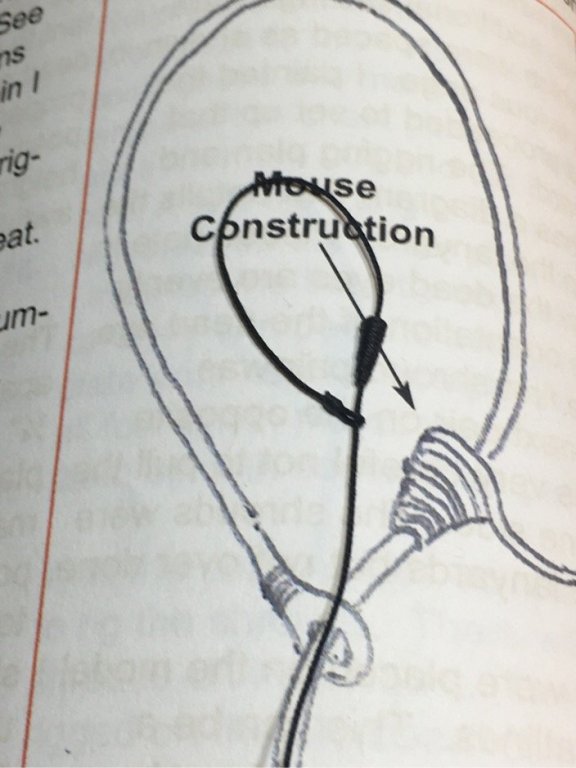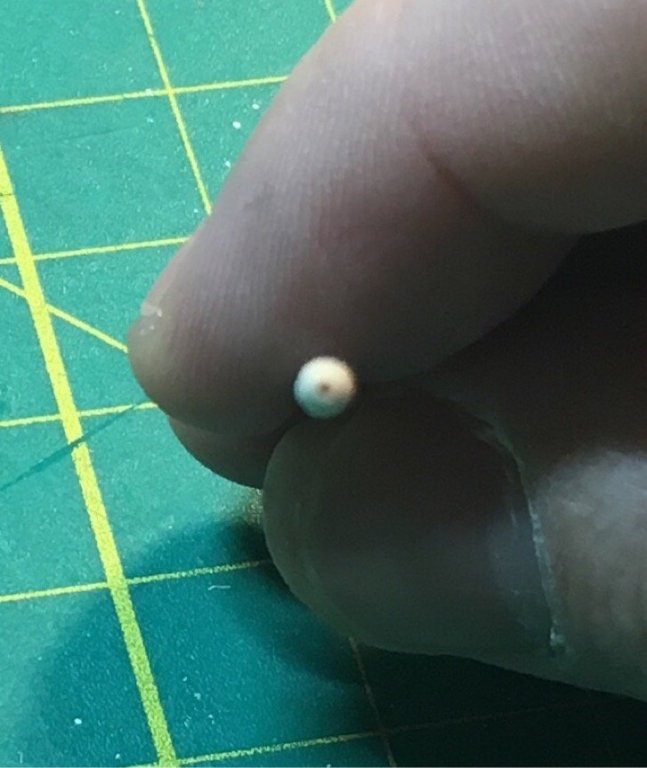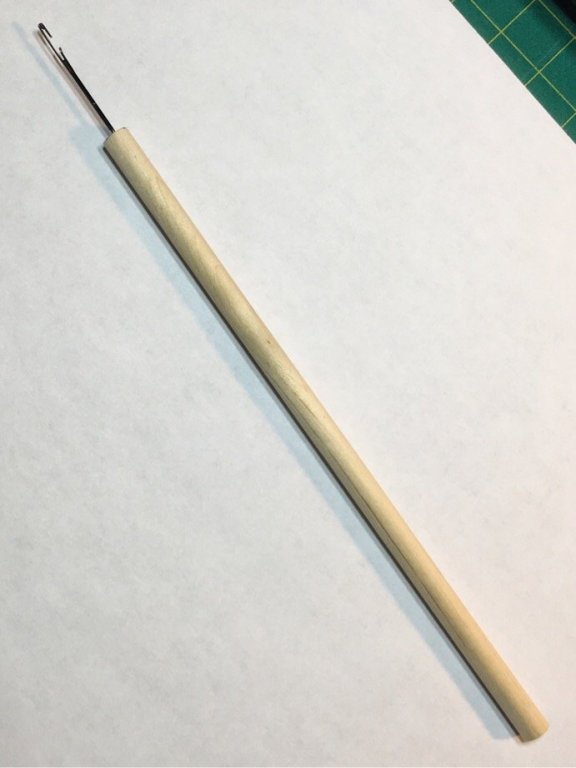-
Posts
1,258 -
Joined
-
Last visited
Content Type
Profiles
Forums
Gallery
Events
Everything posted by Overworked724
-
Ratlins are done. For my first time doing shrouds and ratlins, not a bad result. I learned a lot, and have a good idea of how to improve my result next time around. My little rigging tool I made from a dowel and needle I used extensively and actually found it more useful in helping to tighten up and position the knots. Here are are some photos. As mentioned, my last set of shrouds showed minor ‘hourglassing’ mid’way through...I decided to live with it...live and learn!!! Moving on!!!
- 449 replies
-
- sultana
- model shipways
-
(and 2 more)
Tagged with:
-
Thanks Lou/Ron. I’m probably being overly critical. I did some searching and the frustration of ‘hourglassing’ and dissymetry is not uncommon, especially as folks develop their own skill/technique. I’ll finish them up today and move on. The builder sees the mistakes magnified x10 over. The Admiral just shook her head and told me it looks awesome...then gave me a glass of wine. All better!
- 449 replies
-
- sultana
- model shipways
-
(and 2 more)
Tagged with:
-
Here are a couple pics. Hmmmm...well, when not looking at the shroud dead on, it still looks pretty good. These shots show the difference a bit better.
- 449 replies
-
- sultana
- model shipways
-
(and 2 more)
Tagged with:
-
Hi Lou --- this is exactly what I was thinking! Having a upper and lower 'stabilizer' to minimize the movement of the shroud as you tie your knots...it also keeps you from putting lateral stress on where the shroud crawl up and over the trestle trees. I'm not planning adding sails - only rigging. With that being said, I think I'll plan to move forward. This ship has been a great learning experience - time I started approaching it as such and stop expecting a perfect result. And perhaps you are correct - the impact of the shrouds will be minimized once everything else in place.
- 449 replies
-
- sultana
- model shipways
-
(and 2 more)
Tagged with:
-
Well - I'm 90% done with my ratlines. I'm not posting a photo, because the last shroud I've done seemed markedly different in appearance than the other three. I've been staring at it for a while, and it finally dawned on me why it seems so different...the fact is, my technique seems to have improved over the last three sets of shrouds. This final one seems to have less noticeable distortion of the side shrouds...giving it a more symmetrical, and narrow, appearance versus the other three sets that I've completed. Sigh...CRAP. My eye is magnifying the difference...and it's bugging me. So, the question is whether I redo it/them...which would require redoing both sides...or whether I live and learn, and simply move on with the next steps in the build? I don't know why I'm being so hard on myself...this is my first wooden ship...and it can't be perfect. (Perfect fell by the wayside a LONG time ago) But - a couple of things I might do different.... 1. The miniature rope seemed too heavy (at least for me with the tension I had on th shrouds - which might not have been enough to keep them from distorting as I tied the ratlins)...I used Chuck's recommendation of 0.008" rope....but I found that pulls or pushes the shrouds - depending on whether the ratlin is too taught or slack...it's a maddening balance of ratlin tensile strength versus the vertical taughtness/resistance in the two shrouds you are connecting. I would use smaller gauge rope/thread next time. 2. I was think of using a hairclip (flat duckbill clip) stylists use to hold curlers in ladies hair...I imagine putting these on the shrouds above and below the area you are applying the ratlins might help you keep them more aligned. Just a thought... Moving on...or am I? (conflicted...)
- 449 replies
-
- sultana
- model shipways
-
(and 2 more)
Tagged with:
-
75% complete on the ratlins...good grief, what a chore. A couple challenges: 1. I note that the shrouds over time have relaxed since the day they were initially installed. Not certain what this is from...perhaps the miniature rope relaxed over time. They did not relax to the point of being slack, just not as taught as the first day. The lines were waxed...if that means anything. In future, will plan to do the shroud/ratlins more closely to make the install of the ratlins a bit easier. Looser shrouds make ratlin install a MUCH longer chore...and not a fun chore since the shroud tends to kink, and the ratlins tend to more easily pull or distort the angle of the shroud. 2. Ratlins should be installed to be parallel to the ground (sea). This can be a bit of a problem as your eye tends to drift or tilt to be parallel to the deck. So I found myself really needing to focus the knot placement...and a little bubble level might be useful in future models!!! Moving on. Trying to be consistent!!!
- 449 replies
-
- sultana
- model shipways
-
(and 2 more)
Tagged with:
-
Please let me know when your taking orders!!!!!!! looks awesome!!!!
- 222 replies
-
- sultana
- model shipways
-
(and 1 more)
Tagged with:
-
Awesome! If you can throw in a cutaway for a pipe holder, that would be great!!! (Kidding - I don't smoke)
- 222 replies
-
- sultana
- model shipways
-
(and 1 more)
Tagged with:
-
Hehe! Well, I’m out of the country for business next week, so maybe I’m starting to miss the shipyard in advance! And thanks for for the kind words, Lou! It’s certainly been a learning experience!
- 449 replies
-
- sultana
- model shipways
-
(and 2 more)
Tagged with:
-
Anchors are on! Don’t care about historical accuracy! I love the look!!! Moving on to main mast ratlins!!!
- 449 replies
-
- sultana
- model shipways
-
(and 2 more)
Tagged with:
-
NOOOOO! Why ruin it by putting in a propeller? Are you going to offer the plans both with and without the propeller? =-)
- 222 replies
-
- sultana
- model shipways
-
(and 1 more)
Tagged with:
-
Just a fun pic. Went to the shipyard with my coffee this morning as I was getting ready for work and saw the morning sun lighting up the bow of my ship model. Was so so relaxing....ahhhh...Java!!! Moving on!
- 449 replies
-
- sultana
- model shipways
-
(and 2 more)
Tagged with:
-
OK...it's spelled 'hawser'. However, I think the appropriate term I should be using is 'anchor rope' or 'anchor cable'. Not certain! But it is a bit confusing since it comes out of a 'hawshole' in the ship's bow. A hawser is a rope used to tow, secure, or moor a ship. So...I'm not certain if this applies to anchor cables.
- 449 replies
-
- sultana
- model shipways
-
(and 2 more)
Tagged with:
-
Having fun with the anchors after the catheads led me in that direction. Decided I’ll forego the bouys that we’re typical (and mandatory in many cases) in those days. I can always add them later, like the jolly boat. Found a nice reference in Mondfled’s book on how hausers were tied to the anchor. May not be perfectly historically accurate for this class of ship, but it gave me a good reference point and got me past the builder’s block! Decided I’d set one side up to see how it looked. I am using the cathead as one point of attachment and a knighthead for the flukes as the other point. I liked the end result. Trying to get the hawser to lay down was fun. A couple of tiny touches of CA was the ticket... Out for the evening. It was a fun weekend!!!
- 449 replies
-
- sultana
- model shipways
-
(and 2 more)
Tagged with:
-
Experimented with making blocks with hooks. 😁 The brass pins in the kit are easily bent and shaped to form a nice hook With an eye. A bit of blackening and they turn out pretty decent. (SAND YOUR BRASS BEFORE BLACKENING!!!). Invest in a really small gauge wire bender...it makes making tiny hooks a breeze. I used quilting thread (heavy gauge black nylon) to form the strop...experiments are fun...and made sure there was a friendly groove in the bottom of the block to allow room for the hook. Voilaaaa!!! Decided to go ahead and set up the catheads. A needle threader made things easy here...just moved very slow. Before threading the blocks, I double checked that the hooks comfortably fit into the ring on the anchors. Also, I double checked that I can easily thread the 0.035” rope I bought from Syren which I’ll use to rig the anchor into the haus holes...and it does...no problem. So I can run my anchors after I’ve set up the other two stays which attach to the bullseyes on either side of the foremast. Moving on to the main mast shrouds!!! Shipyard weekends are fun!!!
- 449 replies
-
- sultana
- model shipways
-
(and 2 more)
Tagged with:
-
Just out of curiousity...plank on bulkheads are always a bit of a challenge around the rabbit. Is the keel wide enough trim down to allow a single plank to fit nicely into the rabbit that needs to be shaped without making the keel piece overly thin?? I had this problem when I started the Amati kit for the Lady Nelson. Not certain if it was just me, but a few shipmates at my club said it was a bit of a problem with the kit.
- 222 replies
-
- sultana
- model shipways
-
(and 1 more)
Tagged with:
-
Hi Ron, Many thanks! You are absolutely right. I see the errors, rather than the impression from a first time viewer. The admiral was stunned at how nicely they turned out. But I did learn a lot on my first two shrouds...hoping the next two will turn out as nice. One key lesson is that ratlins can’t be rushed. They really are eye magnets, so getting them right is both a cumbersome task, and a patience marathon. I can’t imagine how the folks who make fully rigged first rates manage this task without going bonkers!
- 449 replies
-
- sultana
- model shipways
-
(and 2 more)
Tagged with:
-
Installed the Fore Stay and Inner Jib Stay. Nice result, I think. We shall see how the rest of the rigging goes! The shrouds are difficult. I did my best, but they do tend to pull out of alignment due to ratlin line tension. But overall, not bad for my first shrouds!!!! Moving on....!!!!
- 449 replies
-
- sultana
- model shipways
-
(and 2 more)
Tagged with:
-
Right!? Better yet...since the Sultana plans are open source, I would start your own company with a competitive kit. The MS kit is a piece of flotsam. The only way to do the MS kit is to ignore everything but the solid hull...I think a laser cut plank on bulkhead would be BRILLIANT!!! 👍🏽👍🏽👍🏽
- 222 replies
-
- sultana
- model shipways
-
(and 1 more)
Tagged with:
-
Well...my first attempt at ratlins was a moderate success. I was actually afraid to start for fear of screwing up. But I made a couple decisions to give me some leeway. The video above helps!! First, I didn’t put CA on any knots until I was done with the entire shroud. That allows for last minute adjustment and you will need it. Second, I found having a sheet of paper helps tremendously. I now have a better feel for how the ratlin thread (too much or too little) between the shrouds can impact the finished shape of the shrouds once the ratlins are installed. You can’t notice without the paper background, but the outer shrouds actually bulge out very very slightly from the ratlin thread tensile strength pushing very slightly outward. Something I’ll be careful of for the next three shrouds. Moving on...
- 449 replies
-
- sultana
- model shipways
-
(and 2 more)
Tagged with:
-
Ok. Word to those who may be doing this for the first time. The mouse needs to be threaded BEFORE you attach the close heart at the end of the Fore Stay!!! I stupidly unthreaded the bullseye and then attached the heart. Yeah...I was not happy...had to rinse and repeat. In doing so, found a good length of 0.025” rope so decided to make the Fore Stay per Chuck’s recommendation since I needed to start over anyway. Also, since I knew I could, I rigged a mouse for the smaller 0.018” rope for the Inner Jib Stay. That’s actually still historically accurate, and seemed to be a reasonable deviation. Below are the pics for the Fore Stay (thicker and shorter) and Inner Jib Stay as they should look BEFORE you put them on the ship. And make sure you thread the bullseye to the mouse BEFORE you measure and attach the closed hearts. You’ll note the closed heart for the Fore Stay is slightly larger than the heart for the Inner Jib Stay. This is because I had a few options for the hearts since I made extras. It seemed the slightly larger heart looked better (but maybe not completely historically accurate) on the thicker rope for the Fore Stay. Okay...time wasting. Time to suck it up and jump into the ratlins!!! Damn the torpedoes!!!
- 449 replies
-
- sultana
- model shipways
-
(and 2 more)
Tagged with:
-
Ok. It’s been a long week and I’m ready to attack ratlins. However, I wanted to take my time with those over this weekend, so opted for a side project. Making the Fore Stay! Chuck’s practicum had him using 0.028” rope as was used for the shrouds. Well, I ran out and my alternate rope sucks. Besides, I checked against the 0.035” rope I plan to use for the anchors and I think the 0.018” rope will suit nicely and not overwhelm the look. Not historically accurate...but it’s my ship and I’ve deviated so much, what is one more deviation!!! The thinner thread make it more difficult to make the mouse...but I had a plan. I decided to use a toothpick!!! My favorite material.... I chopped off the top of a tooth pick with a razor blade, drilled in a hole into the top of the now shorter toothpick, chopped the hollowed piece off which seems to match the look of the mouse, threaded it (the right direction) onto the rope, siezed the bullseye at the other end, wrapped the wooden mouse skeleton in black thread...taaadaaaaa!!!! My fore stay awaits. I’ll sieze the closed heart tomorrow. Moving on...to bed. 😁
- 449 replies
-
- sultana
- model shipways
-
(and 2 more)
Tagged with:
-
I agree! That removes a ton of guesswork done by eyeballing. Also helps inexperienced modelers (me) from over shaping!
- 222 replies
-
- sultana
- model shipways
-
(and 1 more)
Tagged with:
-
Now...if only I knew what a DXF file was...can I open this in Microsoft Office? 😕
- 222 replies
-
- sultana
- model shipways
-
(and 1 more)
Tagged with:
-
Made my own rigging pic tool based on a really good YouTube video on ratlins. No way am I sticking my fat fingers into the rigging again...time to start thinking like a surgeon!!! Thanks to David Kump! note: redid the tie on the sheer pole on the foremast starboard shroud. Muuuuch better.
- 449 replies
-
- sultana
- model shipways
-
(and 2 more)
Tagged with:
About us
Modelshipworld - Advancing Ship Modeling through Research
SSL Secured
Your security is important for us so this Website is SSL-Secured
NRG Mailing Address
Nautical Research Guild
237 South Lincoln Street
Westmont IL, 60559-1917
Model Ship World ® and the MSW logo are Registered Trademarks, and belong to the Nautical Research Guild (United States Patent and Trademark Office: No. 6,929,264 & No. 6,929,274, registered Dec. 20, 2022)
Helpful Links
About the NRG
If you enjoy building ship models that are historically accurate as well as beautiful, then The Nautical Research Guild (NRG) is just right for you.
The Guild is a non-profit educational organization whose mission is to “Advance Ship Modeling Through Research”. We provide support to our members in their efforts to raise the quality of their model ships.
The Nautical Research Guild has published our world-renowned quarterly magazine, The Nautical Research Journal, since 1955. The pages of the Journal are full of articles by accomplished ship modelers who show you how they create those exquisite details on their models, and by maritime historians who show you the correct details to build. The Journal is available in both print and digital editions. Go to the NRG web site (www.thenrg.org) to download a complimentary digital copy of the Journal. The NRG also publishes plan sets, books and compilations of back issues of the Journal and the former Ships in Scale and Model Ship Builder magazines.

